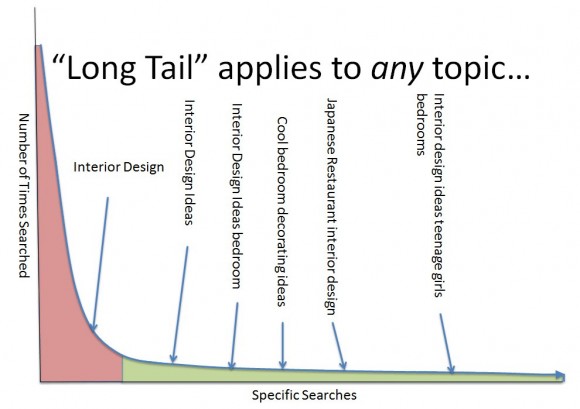How To Do Keyword Research
 After you have determined your SEO objectives, you are now ready to begin researching the keywords on which you will build your content marketing strategy. Keyword research is one of the most important, high-return activities in which you can invest your time. When properly done, keyword research will give you a better understanding of your customers, ever-changing market conditions, and the competitive landscape.
After you have determined your SEO objectives, you are now ready to begin researching the keywords on which you will build your content marketing strategy. Keyword research is one of the most important, high-return activities in which you can invest your time. When properly done, keyword research will give you a better understanding of your customers, ever-changing market conditions, and the competitive landscape.
One of the most important concepts to understand about keywords is the long tail of the keyword demand curve. Although some popular search terms may generate 5,000+ searches per day, the reality of keyword search is that such popular keywords comprise only about 25% of all searches. The other 75% of all searches are what is commonly called the “long tail” of search. In this long tail are millions of unique searches that might occur only once a day, or once ever, but make up the vast majority of keywords that are used to find information through search engines.
 For an example of what types of keywords make up the long tail of a search, take a look at the graph below. As a search becomes increasingly specific, beginning with the generic keyword “interior design”, and moving on to “interior design ideas”, “interior design ideas bedroom”, and culminating in “interior design ideas teenage girls bedrooms”, the volume of searches decreases, but the person performing the search is much more likely to find the exact information that they are looking for.
For an example of what types of keywords make up the long tail of a search, take a look at the graph below. As a search becomes increasingly specific, beginning with the generic keyword “interior design”, and moving on to “interior design ideas”, “interior design ideas bedroom”, and culminating in “interior design ideas teenage girls bedrooms”, the volume of searches decreases, but the person performing the search is much more likely to find the exact information that they are looking for.
 The long tail means the following for your keyword strategy:
The long tail means the following for your keyword strategy:
- The world is made up of people with very specific information needs. People find information mostly by very specific searches.
- Expect these to take them directly to content of interest – they won’t necessarily enter your website via your home page.
- Therefore, every page should be a complete experience, and a compelling introduction to your site.
- Your site doesn’t have to rank highly for some popular query to get lots of traffic. Don’t try to be #1 for “design” – there is too much competition. Only the very top results get any user attention.
- Popular keywords won’t generate the traffic you want. They won’t result in a meaningful interaction unless you truly have the world’s best general resource for design information.
- “Optimal” traffic comes when you have the world’s best page for some very specific information need. Each of these generates a tiny bit of high-quality traffic.
- Make it up in volume! Have lots of specific, useful content on your site. In practical terms: post often to your blog, and create lots of specific content.
Where can you get the information you need about keyword demand? A number of excellent free resources exist to help you do this research:
- Google Adwords’ Keyword Estimator
- Google Insights for Search
- Google Trends Keyword Demand Prediction
- Microsoft AdCenter Keyword Forecasting
- Wordtracker’s Free Basic Keyword Demand
These tools will help you determine the number of monthly searches for each keyword term, the level of competition to gain a high ranking, trends in volume, and closely related search terms. Google’s Keyword Estimator will even examine your website for you and suggest keywords based on the content of your site! This useful tool will reveal whether you are on the right track in creating the content on your site that is consistent with your keyword strategy. Other tools for advanced keyword research exist, and these are covered excellently in the Professional’s Guide to Keyword Research.
Keyword research will help you determine the core set of keywords that help you achieve your SEO objectives. You can then build your content around these keywords. By monitoring your rankings for these keywords on a regular basis, you can track your progress in attracting qualified traffic to your website.
